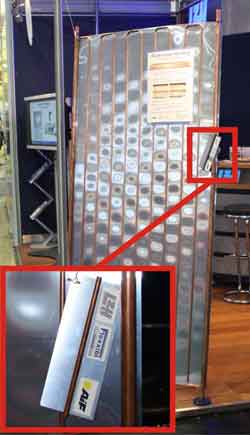Optimized Production of Solar Absorbers

The quality of the diode laser welded Cu-Al connection (small section hanging on the solar absorber) impressed the EuroBlech fair visitors.<br>
A new laser welding process promises both an enormous potential for saving energy and higher welding strengths for the manufacturing of solar absorbers. The main element of this innovative process is a diode laser, which is used to join the copper tubes to the aluminum absorber sheet, instead of using the conventional solid-state laser. The Laser Zentrum Hannover e.V. (LZH) presented first successful results of this project at the end of October at the fair EuroBlech 2010.
Solar absorbers stand for energy savings. As the main element in solar collector systems, they use the sun's energy to warm up water and save on heating costs. However, much energy is needed to manufacture the solar absorbers. To weld the copper tubes to the absorber sheets, most manufacturers use two pulsed, solid-state lasers with peak energies up to 6 kW. These flashlamp pumped lasers have a rather low working efficiency, making laser processing very energy intensive, and expensive.
The group “Joining and Separating of Metals” of the Materials and Processing Department of the LZH uses only one 4 kW diode laser for the welding process. This laser not only has a much higher efficiency rate, but it also uses the laser energy better, because copper and aluminum both have higher absorption characteristics for the typical diode laser wavelengths used (800 to 980 nm). A further advantage is that the size of the welding spots can be increased, and wider welding spots mean higher weld stability. It is especially important that the thermal input can be regulated, as an excessive thermal load could damage the absorber coating.
The cooperative project between the Hannoverian laser researchers and the metal-working company Flexxibl GmbH from Brunswick, Germany, is now entering a decisive phase. Following the positive resonance to the welding results shown at the EuroBlech, the partners are now working on developing a new laser processing head for solar absorber welding. In the spring of 2011, they plan on presenting this new diode laser welding head to the absorber industry.
The project (project number KF2186401AB9) is supported by AiF (German Federation of Industrial Research Associations) and runs until the end of February 2011.
Contact:
Laser Zentrum Hannover e.V.
Michael Botts
Hollerithallee 8
D-30419 Hannover
Germany
Tel.: +49 511 2788-151
Fax: +49 511 2788-100
E-Mail: m.botts@lzh.de
The Laser Zentrum Hannover e.V. (LZH) carries out research and development in the field of laser technology and is supported by the Ministry of Economic Affairs, Labour and Transport of the State of Lower Saxony (Niedersächsisches Ministerium für Wirtschaft, Arbeit und Verkehr).
Media Contact
More Information:
http://www.lzh.deAll latest news from the category: Process Engineering
This special field revolves around processes for modifying material properties (milling, cooling), composition (filtration, distillation) and type (oxidation, hydration).
Valuable information is available on a broad range of technologies including material separation, laser processes, measuring techniques and robot engineering in addition to testing methods and coating and materials analysis processes.
Newest articles

Innovative 3D printed scaffolds offer new hope for bone healing
Researchers at the Institute for Bioengineering of Catalonia have developed novel 3D printed PLA-CaP scaffolds that promote blood vessel formation, ensuring better healing and regeneration of bone tissue. Bone is…

The surprising role of gut infection in Alzheimer’s disease
ASU- and Banner Alzheimer’s Institute-led study implicates link between a common virus and the disease, which travels from the gut to the brain and may be a target for antiviral…

Molecular gardening: New enzymes discovered for protein modification pruning
How deubiquitinases USP53 and USP54 cleave long polyubiquitin chains and how the former is linked to liver disease in children. Deubiquitinases (DUBs) are enzymes used by cells to trim protein…



